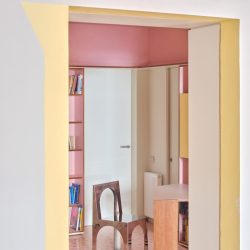
AMOO | Aureli Mora + Omar Ornaque . photos: © José Hevia
The apartment takes up the entire second floor of a small residential building between partitions in the Guinardó neighbourhood. It opens onto two façades, the street and the inner patio of the block, and is developed around an open interior courtyard, bringing a great light to the interior spaces.
The original structure of the house is very rational, delimiting three large rooms, each of which is excessively compartmentalised with an archaic distribution that does not respond to the needs of the family structure and the wishes of the new property. The project is particularly focused on resolving this conflict.
Firstly, by identifying the three large spaces defined by the three corridors of the house: the space towards the street, the central space and the space towards the inner courtyard of the block.
Secondly, by defining the central space as a multi-functional element that is at the other two’s disposal, simultaneously acting as a hall, distributor, meeting point and storage and study, with a perimeter piece of furniture that organises the up to 10 doors or windows that open onto it.
Thirdly, by defining the uses of the other two spaces and identifying the space towards the street as a daytime space (living room-dining room-kitchen) and the space towards the inner courtyard of the block as a night space (2 bedrooms).
This rationality applied in the process of re-distribution and conception of spaces is formally distorted through the introduction of a large continuous element of broken geometries alien to the established order, which acts as a permeable partition between different spaces and links them, transforming into a dining room, kitchen, laundry room and study along its route.
This break is also caused by the material and chromatic choice of the interior set and its application in a pop collage style, which is related to the owners’ personality and lifestyle. In this sense, a variety of materials are introduced, such as national granite, terrazzo, iroko wood parquet, melamine, mirrors, wood veneers and paint, often intertwining, as in the case of the stone ‘carpet’ of the central space, made with pieces of pink terrazzo with large chips of national granite.
In short, it is an exercise of common sense and rashness located in Segle XX (20th century) Street, which seeks a timelessness from the 21st century.
_
SEGLE XX
AMOO | Aureli Mora + Omar Ornaque
Refurbishment of a flat on Segle XX Street.
authors: AMOO | Aureli Mora + Omar Ornaque @amoo.studio
location: Segle XX Street 21, Barcelona
start/end of the project: 2021-2022
start/end of the construction: 2022-2023
photographer: José Hevia
collaborators: Inès Martinel
client: private
area: 79,55 m²
La vivienda ocupa toda la planta segunda de un pequeño edificio de viviendas entre medianeras en el barrio del Guinardó, se abre hacia dos fachadas, la de calle y la del patio interior de manzana, y se desarrolla en torno a dos patios, aportando gran calidad lumínica general a los espacios interiores. La estructura original de la vivienda es muy racional, delimitando tres grandes crujías, cada una de ellas excesivamente compartimentada con una distribución arcaica que no responde a las necesidades de la estructura familiar y la voluntad de la nueva propiedad. El proyecto se centra especialmente en resolver este conflicto. En primer lugar, identificando los tres grandes espacios definidos por las tres crujías de la vivienda: espacio hacia la calle, espacio central y espacio hacia el patio interior de manzana. En segundo lugar, definiendo el espacio central como elemento plurifuncional servidor de los otros dos, ejerciendo a la vez de vestíbulo, distribuidor, espacio de relación y almacenamiento y estudio, con un mueble perimetral que ordena las hasta 10 puertas o ventanas que abren hacia el mismo. En tercer lugar, definiendo los usos de los otros dos espacios e identificando el espacio hacia la calle como espacio diurno (estar-comedor-cocina) y el espacio hacia el patio interior de manzana como espacio nocturno (2 habitaciones). Esta racionalidad aplicada en el proceso de redistribución y concepción de los espacios se distorsiona formalmente mediante la introducción de un gran elemento continuo de geometrías quebradas y ajeno al orden establecido, que hace de biombo permeable entre diferentes espacios y los enlaza, transformándose en comedor, cocina, lavadero y estudio a lo largo de su trazado. Esta ruptura también viene provocada por la elección material y cromática del conjunto interior y en su aplicación a modo de collage pop, que se relaciona con la forma de ser y querer vivir de los propietarios. En este sentido, se introducen diversidad de materiales como el granito nacional, el terrazo, el parqué de madera de iroko, la melamina, los espejos, los rechapados de madera y la pintura, muchas veces entrelazándose, como en el caso de la 'alfombra' pétrea del espacio central, realizada con piezas de terrazo rosa con grandes chips de granito nacional. En definitiva, un ejercicio de seny y rauxa ubicado en la c. Siglo XX, que busca una atemporalidad desde el s. XXI.






















